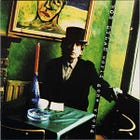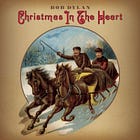Good As I Been To You/World Gone Wrong – Part 2: The Csus4 Thing (Dylanology 24)
It's hardly even a chord, but it plays several parts on Dylan's acoustic 90s albums
In the previous issue, I discussed the Bass Melody type of playing, where the melody of the song is picked out wholly or partly in the bass while the rest of the chords are strummed between the bass notes.
In today’s text I move on to the next main group of songs on the two acoustic 90s albums: what I call «the Csus4 Thing».
This obviously revolves around the use of the Csus4 chord.
Theory corner. The sus4 chord is a chord where the third is sus’ed – «suspended» – temporarily replaced by the fourth, so that the C chord no longer consists of the tones c-e-g, but rather c-f-g.
This does two things: when the third is gone, the chord is no longer neither major nor minor, since that is decided by the third; and where there used to be the most perfect harmony, there is a dissonance (f-g) instead.
In the discussion of «This Night Won’t Last Forever» in issue 8, I highlighted two main uses of the sus4 chord: to utlise the tension that comes with the dissonance f-g as a motor, with the goal of eventually reaching F:
Or as a flourish of a plain C chord, with an ornamental rather than a forward-driving function, e.g. the intro to Lennon’s “Woman”.
But on the two early-90s acoustic albums, the chord has a third and fourth function: (3) it can work as a stand-in for an F major chord, and (4) it is yet another way of creating some kind of melodic substance in the guitar part. It is thus related to the Bass Melody style, only this time it’s a countermelody that is produced.
Dylan in Duet
Which is not an obvious path for Dylan to take. One thing about Dylan as a singer is agreed upon by most of those who have tried to sing with him: he can be a terrible duet singer, especially when he is the one who is supposed to sing the second part. True to his nature, Dylan cannot be counted on to hold a melody steady enough for someone to easily add a backing part, and he is even less likely to produce enjoyable backing vocals himself (e.g. the duets with Van Morrison). Most singers who try to accompany him fail. Famously, Emmylou Harris was quite unhappy about her – by the way excellent! – duets on Desire, and I suspect that Patti Smith may have regretted her choice to sing “Dark Eyes” in duet with Dylan back in 1995. Only Joan Baez has always been successful in this particular department.
But on the Csus4 songs on GAIBTY and WGW, his “dueting” is impeccable.
If you like what you’re reading, and/or if you would like to support the work I’m doing on dylanchords.com, please consider a subscription, if you haven’t already.
Keep reading with a 7-day free trial
Subscribe to Dylanology to keep reading this post and get 7 days of free access to the full post archives.








